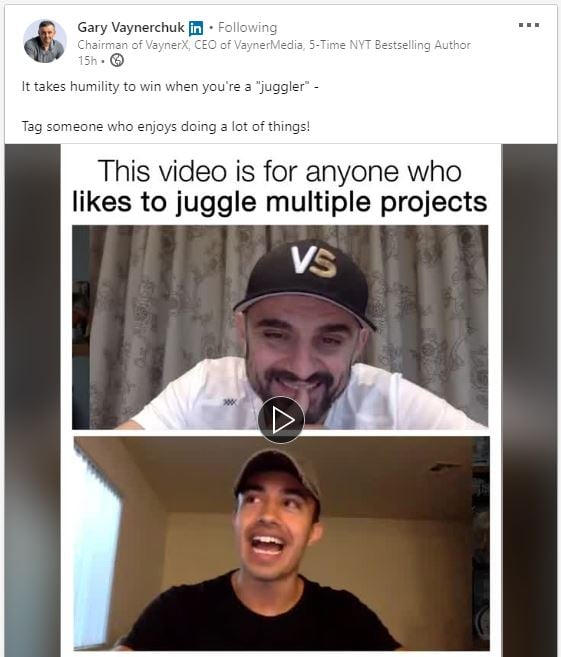If there’s one constant in the world of marketing, it’s that everything changes.
Whether it’s the Google algorithm upending your SEO efforts, Facebook pulling the organic page reach rug out from under you or a worldwide pandemic decimating your in-person marketing plans, life is always changing.
So what happens when your conference marketing budget goes on hold and you need to reallocate the funds and the efforts?
How do you pick up the pieces and refocus your conference marketing efforts to still drive revenue for your business?

If you’ve found your trade show lead generation plan up in smoke, it’s time to take the power back.
Where to Reallocate a Conference Marketing Budget
- Create LinkedIn Content
- Produce Videos
- Offer Live Video Streams
- Lean Into a Conversational Strategy
- Explore Podcasting
- Launch a Social Media Advertising Campaign
1—Create LinkedIn Content
Conferences and trade shows can be great places to make professional connections. B2B lead generation from a vendor booth to hallway conversations comes from live events.
Where can your sales team do the same in a digital world? LinkedIn!
Your team can create their own content or share company resources to make connections, build trust and drive leads.
LinkedIn is a professional social network focused on career development, sure. But it’s also made for professional connections, industry discussions and other types of business-related activities.
Businesses have direct access to consumers that they can easily market to with status updates, images and other casual posts. Exercise caution, though: Blatantly pushing your business, spamming and obvious hard selling is highly frowned upon. Because the network consists of a totally different audience than other networks like Instagram or Twitter, LinkedIn marketing requires a different type of approach to get the results you want.
Your marketing and sales team should be sharing value in the forms of:
- Simple posts
- Original articles
- Curated content
- Videos
- Live video
In addition to creating and sharing content, your teams should also take part in conversations. Naturally. Weigh in on discussions with peers and possible clients to build awareness and trust.
GaryVee is a great example of always pushing content and trying new things with his audience.
How can you put this inspiration to work in your business?
2—Produce Videos
In addition to LinkedIn, video works well on almost every platform. From social media to your website to email, video is a great place to allocate budget. The equipment, the time and the humans it takes to produce videos may have turned you off of the strategy.
There’s no greater time to invest in video than right now.
Bringing value to your prospects and potential clients through video helps position you as a trusted advisor.
Building that value so it converts an audience into leads and customers begins with understanding where they are in their own path, from awareness of a problem to the decision stage.

Awareness Stage Videos
As you know, in the awareness stage your prospect has a problem they need to solve and you know you have the solution they need. This is where you help them begin to connect the dots. You get to empower them to recognize what they’re looking for by providing helpful answers, insight and expertise.
The typical awareness stage video looks like this:
- Short format (30-90 seconds)
- General and helpful how-to content
- Fun company culture videos
- Inspirational, motivating content
Consideration Stage Videos
During the consideration stage, your audience has moved beyond simply being aware of a problem. They’re researching specific solutions and considering options for solving their problem. It’s time to showcase what you offer and explain why you would or wouldn’t be a good choice.
Here are a few ideas and tips for videos you can create for this stage:
- Medium to longer format 2-10 minutes)
- Both informative and engaging (even entertaining)
- These can include:
- Explainer videos
- Product demos
- Testimonials
- Case studies
Decision Stage Videos
Once your buyer is ready to make a purchase, they’re ready to decide. Deep-content videos position you as the best choice. Since they’re deciding on what specifically to purchase and from whom, your job is to make this a no-brainer with details.
What that could look like:
- Videos of nearly any length
- FAQ videos
- Testimonials, reviews and unboxing (user generated content is great here)
- Instructional or in-depth product features guide
3—Offer Live Video Streams
In addition to well-produced videos, connecting with an audience through live streaming can be powerful in your marketing strategy.
Live video helps you create a sense of urgency and real-life connection with prospects. Facebook, Instagram and LinkedIn all offer live streaming in addition to tools like YouTube.
From social media to video streaming platforms, you can host a virtual event complete with actual networking for your sales team.
What are some ideas for live video? Here you go:
- Behind-the-scenes content
- Dat to day activities at your business
- Impromptu interviews with your team
- “Culture” videos like lunch breaks
- Blog posts can be live videos
- Breaking news from your industry
- FAQs in a Q&A format
Live video is a powerful tool for your online marketing strategy.
4—Lean Into a Conversational Strategy
Another place to move your conference budget, which involves in-person conversations, is conversational marketing. From live chat to chatbots to emails that elicit replies, conversational has become a great lead generation strategy.
![]() When you engage prospects in conversation and listen (literally or through chat), you create a connection that builds trust in a way they’re used to. Messaging, chat and texting have turned this marketing strategy into a powerful one for many businesses.
When you engage prospects in conversation and listen (literally or through chat), you create a connection that builds trust in a way they’re used to. Messaging, chat and texting have turned this marketing strategy into a powerful one for many businesses.
The Tools of Conversational Marketing
Live Chat
This is where most businesses start. Adding a chat feature to your website means you have a person on the other end ready to answer questions and direct someone to the right person to help them.
This is like answering someone calling you or walking in your front door. A friendly, helpful tone helps set the prospect at ease. Then by helping them with what they need, answering their questions and offering resources, you’ll build trust in your brand.
It’s important to loop in your sales team for lead generation, but also have your service team or an account team (inside sales) ready to help current customers with their questions.
A few live chat tips:
- Introduce yourself by name just like you would in person
- Converse, don’t immediately “sell”
- Script canned responses to answer frequently asked questions
- Be conversational but be aware of grammar
Chatbots
It’s not cost-effective to staff live chat 24/7. That’s where chatbots come in.
Chatbots with artificial intelligence (AI) have grown to become smart and efficient with the ability to process data, track patterns and respond quickly. You can use bots while your staff isn’t available or to answer those questions most often asked.
Bots aren’t meant to replace human connection, but enhance it. Think of these quick automatic responses as merely an initial touch point. For simple questions and requests, a chatbot can serve a quick answer.
If a chatter asks how late you’re open, you can program your bot to serve up your hours of operation—straightforward results without the need for your team to interact.
Social Media Messaging
Social media has become inextricably woven into our everyday lives. It’s a basic communication tool that connects us all. As it’s gained popularity around the world, it’s become a way of life.
Since the introduction of mobile phones as powerful as supercomputers, access to the social network is more accessible than ever. So it’s no wonder that social media messaging has become another popular channel for interaction for all of us to communicate, share knowledge and ideas, create and exchange information within a virtual network.
Businesses like yours are looking for all possible ways to connect with potential and existing customers. We all want to remain relevant and connected to our prospects.
Taking your business’s social media a step forward with the use of messaging apps is not limited to bring you closer to your customers but serves as another avenue to ensure customer satisfaction.
5—Explore Podcasting
Podcasting has exploded in recent years. With the growth comes a buy-in from companies who see the value of connecting with listeners who could become clients. In fact, many businesses have jumped into the podcast world.
Looking at this medium by the numbers and you can see why.

- 1 in 3 Americans listen to podcasts monthly
- 1 in 4 Americans listen to podcasts weekly
- Podcast listeners are affluent - more likely to make more than $75,000 per year
- Over half of listeners are more likely to consider buying an advertised product
Source: 14 Critical Podcast Statistics
There are a couple of ways to tap into the podcast medium as you reallocate your marketing budget.
Launch Your Own Podcast
First, you can create your own show and bring a ton of value to your audience. Wondering what kind of show?
- A monologue-style show where you impart wisdom and experience
- You interview thought leaders to bring them to your audience
- A hybrid of the two
The key is to offer your audience a unique perspective and build a community. You could bring them into a private Facebook Group, an email list, a membership site, a Slack channel or some other community. The point is to make sure people can connect with you on some level.
Whatever style of show you consider creating, the bottom line is that you’ll want to decide how much work and financial support you can put into it.
Become a Sought-After Podcast Guest
Another podcast strategy for your marketing is to bring your story to an existing audience as a podcast guest. Find a show your buyer personas listen to and work to make a connection with the host or producers.
Podcast interview marketing has helped tons of brands build awareness and drive leads. Here’s how:
- Appear on podcasts as a subject matter expert
- Send listeners to your website (a custom landing page for each show is ideal)
- Build a following and net more shows
6—Launch a Social Media Advertising Campaign
 Where else can you move a budget that’s no longer viable for lead generation? How about social media advertising?
Where else can you move a budget that’s no longer viable for lead generation? How about social media advertising?
Each of the major platforms where we all spend our time offer businesses an opportunity to pay for access to a strategic, specific audience.
The social media companies understand that data is everything, and they each allow a brand to slice-and-dice and audience to reach the most relevant eyeballs. That’s a win for any business looking to build awareness and drive leads.
Tips for a successful social media advertising strategy:
- Be clear on your business objective
- Know your target audience deeply
- Create organic posts that support your advertising
- Decide what’s important—engagement versus impressions
- Design with mobile in mind
- Use more than one media—text, photo, video
- Measure and report on progress
Social Media ProTip: Engage with Your Brand Connections
In addition to generating new leads for your business through social media, you should also engage with the people who are already connected to your brand.
Social media is, after all, social. Even if you’re paying to get in front of people, they can be the audience already familiar with your brand so you’re staying in touch and creating conversation.
The ads you create can target your current audience to reaffirm their connection with your brand. Boosting posts that offer value gets them to re-engage, boosting your reach and bringing those who already like you back into your conversation.
In addition to paid posts, you can use social media messaging—detailed below in conversational marketing—to have direct conversations with your connected audience.
Reallocating a Conference Marketing Budget
If conferences and trade shows are all about making connections and deepening relationships, finding the channels that fit this goal for your business will help you find the places to reallocate funds.
Besides moving money, you’ll also consider the time and resources it takes to be successful in driving leads to your sales team.
Each of these tips above are tactics in a digital marketing strategy. While a live video stream may not have quite the same impact as taking a potential client to dinner, becoming a skilled digital marketer will help you grow your business through any difficult times you’ll face.

